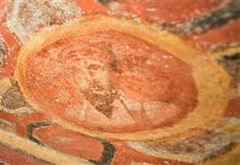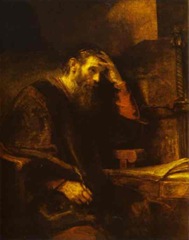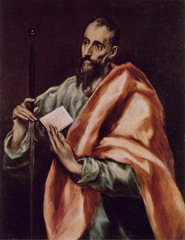 Last year an ancient watercolor of Paul was discovered in Rome, and last week it was announced that laser cleaning of the same 4th century catacomb revealed ancient icons of other disciples.
Last year an ancient watercolor of Paul was discovered in Rome, and last week it was announced that laser cleaning of the same 4th century catacomb revealed ancient icons of other disciples. ![]() On the left is the watercolor of Paul and on the right is the icon of Peter.
On the left is the watercolor of Paul and on the right is the icon of Peter.
These discoveries raise the question, what did the apostle Paul look like? The answer, of course, is that we don’t know. Neither his own writings nor the Acts of the Apostles, the two canonical sources of information about the apostle to the Gentiles, contain any physical description. The first known description comes from a work of popular fiction dated to the end of the 2nd century entitled The Acts of Paul and Thecla. Although this work is obviously fictional and the description purely speculative, its influence persists. This is how Paul is described by the unknown author:
he was a man of middling size, and his hair was scanty, and his legs were a little crooked, and his knees were projecting, and he had large eyes and his eyebrows met, and his nose was somewhat long, and he was full of grace and mercy; at one time he seemed like a man, and at another time he seemed like an angel.
Walt Wangerin in his work Paul, a novel picks up on this ancient description:
Here was a small man sitting cross legged … his head a monument for hugeness … eyebrows thick and dark and joined in the middle; his nose both narrow and hooked; his eyes red-rimmed in that tremendous skull; a swift mouth, moist red lips … an orange worm of a scar at the hairline.
For my part in A Wretched Man, I deliberately shied away from the traditional image of the bow legged tiny man. Instead, I made him tall and gangly but the pointy nose remained, all the better to tug on for inspiration. With legs too long and a beak nose, his young friends teased him with the nickname “Stork” at the outset of the novel.
 When it came time for the publisher to design the cover for A Wretched Man, we quickly narrowed our focus to a pair of Renaissance portraits. I liked Rembrandt’s Apostle Paul because it seemed to capture the angst of the man, and it fit the novel’s title. But, since the novel had already been written, and the long nose oft described, there was something about the man’s impudent, elongated nose—prying and eager to poke into matters that were not his concern (from the point of view of Paul’s nemesis, Ya’akov), we chose instead the portrait of Paul by another artist of the Renaissance, the Spaniard who went by the name of “The Greek”—El Greco.
When it came time for the publisher to design the cover for A Wretched Man, we quickly narrowed our focus to a pair of Renaissance portraits. I liked Rembrandt’s Apostle Paul because it seemed to capture the angst of the man, and it fit the novel’s title. But, since the novel had already been written, and the long nose oft described, there was something about the man’s impudent, elongated nose—prying and eager to poke into matters that were not his concern (from the point of view of Paul’s nemesis, Ya’akov), we chose instead the portrait of Paul by another artist of the Renaissance, the Spaniard who went by the name of “The Greek”—El Greco.
The artist in each portrait painted pages or notes to signify Paul the writer of letters—an anachronism since Paul would have written his letters on papyrus scrolls rather than individual pages, but the Renaissance artists failed to note that historical detail. Obtaining the rights to use El Greco’s portrait of Paul was quite simple and not expensive. Turns out there is a New York brokerage that handles such issues simply and online.
UPDATE: July 5, 2011
Another ancient Fresco of Paul has been discovered in Naples, dating to the sixth century.
A photograph released by the Vatican shows the apostle … with a long neck, a slightly pink complexion, thinning hair, a beard and big eyes that give his face a “spiritual air.”
